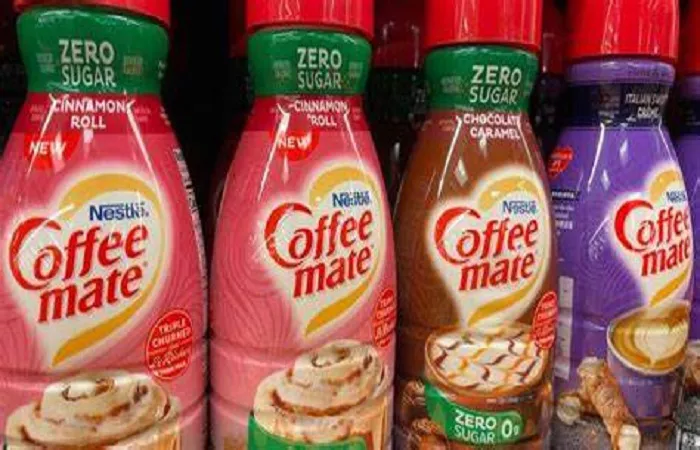Coffee is one of the most popular beverages in the world. Many people enjoy adding creamers and sweeteners to their coffee to enhance the flavor. One popular brand of non-dairy creamer is Coffee Mate. They offer a sugar-free version for those looking to reduce their sugar intake. But what exactly is used to sweeten sugar-free Coffee Mate? In this article, we’ll take a closer look at the sweeteners in sugar-free Coffee Mate and discuss their properties.
Overview of Coffee Mate
Coffee Mate is a non-dairy creamer owned by Nestlé. It was first introduced in 1961 and has since become a staple in many households and coffee shops. Coffee Mate is designed to mimic the creamy texture and taste of dairy creamers without using any milk or cream.
The original Coffee Mate contains corn syrup solids and sugar as sweeteners. However, the sugar-free version replaces these with artificial sweeteners to provide sweetness without the calories and carbs of sugar.
Sweeteners Used in Sugar-Free Coffee Mate
Sugar-free Coffee Mate contains two main artificial sweeteners:
Sucralose
Sucralose is a zero-calorie artificial sweetener that is made from sugar. It is about 600 times sweeter than regular sugar. Sucralose is not broken down by the body, so it passes through without being metabolized. This means it does not impact blood sugar or insulin levels.
Sucralose is heat-stable, so it maintains its sweetness even when added to hot coffee. It also has a clean, sugar-like taste without any bitter aftertaste. These properties make sucralose a popular choice for use in sugar-free products like Coffee Mate.
Acesulfame Potassium (Ace-K)
Acesulfame potassium, also known as Ace-K, is another zero-calorie artificial sweetener. It is about 200 times sweeter than sugar. Like sucralose, Ace-K is not metabolized by the body and does not affect blood sugar.
Ace-K has a slightly bitter aftertaste on its own. However, when combined with other sweeteners like sucralose, the bitterness is masked. The combination provides a more balanced sweetness profile. Ace-K is also heat-stable, making it suitable for use in hot beverages.
Why These Sweeteners Are Used
Sucralose and Ace-K are used in sugar-free Coffee Mate for several reasons:
Zero Calories: Both sweeteners provide sweetness without adding any calories. This allows sugar-free Coffee Mate to be a low-calorie alternative to regular creamers.
No Impact on Blood Sugar: Since sucralose and Ace-K are not metabolized, they do not cause spikes in blood sugar levels. This makes sugar-free Coffee Mate suitable for diabetics and those monitoring their carb intake.
Heat Stability: The sweeteners maintain their sweetness even when added to hot coffee. This ensures consistent flavor.
Synergistic Sweetness: The combination of sucralose and Ace-K provides a more balanced sweetness that closely mimics sugar. The two sweeteners work together to mask any bitter aftertastes.
Cost-Effectiveness: Artificial sweeteners are much more potent than sugar, so only small amounts are needed. This makes them a cost-effective choice for manufacturers.
Safety of Artificial Sweeteners
Some people have concerns about the safety of artificial sweeteners like sucralose and Ace-K. However, both sweeteners have been extensively studied and approved for use by major health organizations.
The U.S. Food and Drug Administration (FDA) has approved sucralose as a general purpose sweetener. It has also set an Acceptable Daily Intake (ADI) of 5 mg per kg of body weight. To reach this limit, a 150 lb person would need to consume over 30 packets of sugar-free Coffee Mate per day.
Similarly, the FDA has approved Ace-K as a safe sweetener with an ADI of 15 mg per kg of body weight. A 150 lb person would need to consume over 90 packets per day to exceed this limit.
The European Food Safety Authority (EFSA) and other international health organizations have also deemed these sweeteners safe for consumption at typical intake levels.
Taste and Texture Compared to Regular Coffee Mate
While sugar-free Coffee Mate provides a similar creamy texture to the original, there are some differences in taste:
Sweetness: Sugar-free Coffee Mate is slightly less sweet than the original. The sweetness may also have a slightly different profile due to the use of artificial sweeteners.
Aftertaste: Some people detect a mild aftertaste from the artificial sweeteners, especially if used in large amounts. However, the combination of sucralose and Ace-K helps minimize this.
Mouthfeel: Sugar-free Coffee Mate may feel slightly thinner or less rich than the original due to the lack of sugar and corn syrup solids. However, the difference is subtle.
Overall, sugar-free Coffee Mate is designed to closely mimic the taste and texture of the original while eliminating sugar and reducing calories.
Using Sugar-Free Coffee Mate
Sugar-free Coffee Mate can be used just like regular Coffee Mate. Simply add it to your coffee to taste. You can also use it in recipes that call for non-dairy creamer.
Keep in mind that sugar-free Coffee Mate may not provide the exact same taste and texture as the original. You may need to experiment with the amount to achieve your desired sweetness and creaminess.
Conclusion
Sugar-free Coffee Mate is a popular choice for those looking to enjoy a creamy coffee without the sugar and calories. It uses a combination of sucralose and acesulfame potassium to provide sweetness while keeping the product low-calorie and suitable for diabetics.
While the taste may differ slightly from the original, sugar-free Coffee Mate is designed to closely mimic the flavor and texture of regular Coffee Mate. It’s a convenient way to enjoy a sweet, creamy coffee without the guilt. As with any food product, it’s important to consume sugar-free Coffee Mate in moderation as part of a balanced diet. But for most people, it can be a safe and enjoyable alternative to sugar-sweetened creamers.
Related topics:


